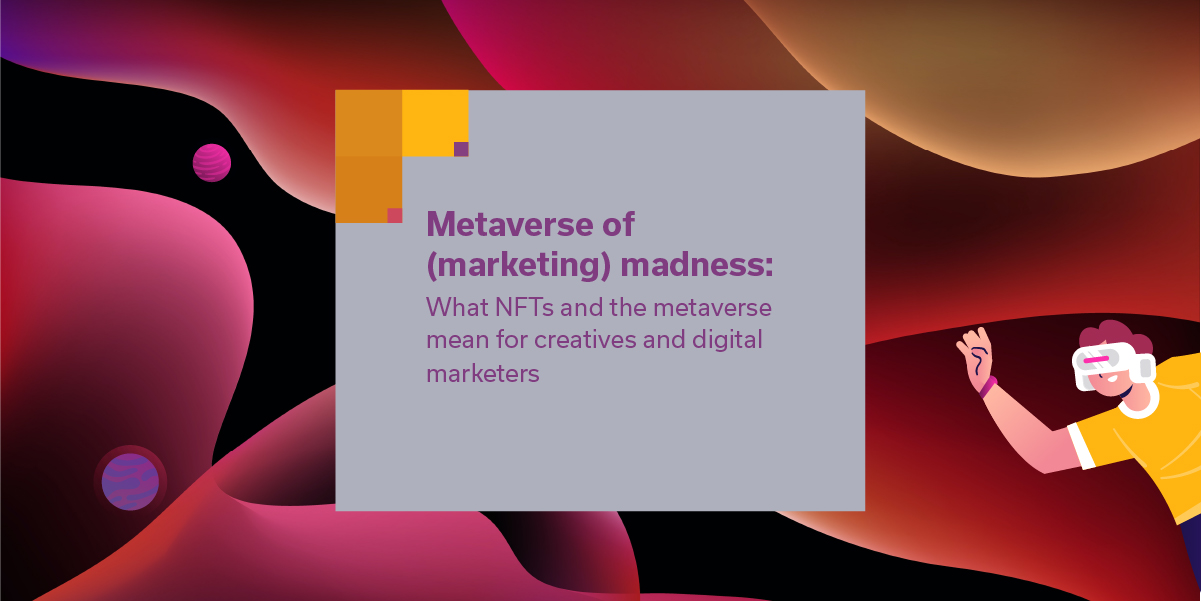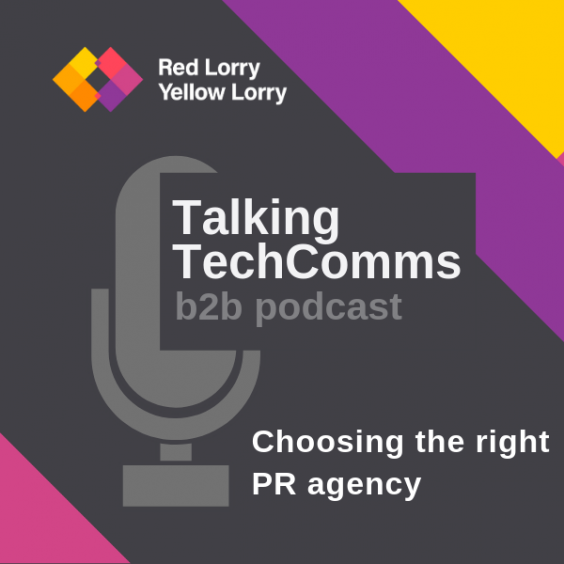Ready to jump down the metaverse marketing rabbit hole? Digital account executive George will be your guide…
Having spent the last few years working in b2c advertising before moving to b2b marketing, I would say I’m fairly well-versed in Web 2.0, despite still learning something new each day. Web 3.0 however, with the metaverse and our NFT-clad alter egos, is an entirely different beast.
But why and how? Simply put, unlike Web 2.0, where a single entity like Facebook (Meta) controls each platform, Web 3.0 is built by and for the community. This gives power to the people and more freedom (at least in theory). Admittedly, the concept of buying virtual clothes to wear to a virtual gig using your NFT event ticket seems more b2c than b2b. But we’re a creative industry, so b2b use cases will inevitably follow.
So, what could the future of NFT and metaverse marketing look like? Here are my thoughts…
Metaverse
The metaverse is a concept from fiction (see the 1992 book Snow Crash). It’s based on free movement and fluidity between the real world and the digital one – as easy as taking a VR headset on and off. You can see it visualised nicely below. Because it doesn’t yet exist, the following ideas, benefits and risks of b2b marketing in the metaverse are all speculative, and essentially just me thinking out loud.
Innovations in creativity would be the most immediate usage I can think of for the metaverse in b2b marketing. Brands can promote themselves in a more creative manner to clients, getting across brand identity in a different way to that previously seen in print, digital or on social platforms. According to Meghan Crown, co-founder of Mixed Reality Rooms, an organisation dedicated to building a b2b metaverse, “it’s super easy in a digital setting to make spaces feel extremely personalised for the folks you bring in. With Mixed Reality Rooms, you’d build a metaverse designed to deliver a specific set of information (like a product pitch or training) but then have the ability to customise the details to make it feel super special and personalised to whichever account or prospect you’re hosting the experience for.“
Networking opportunities also spring to mind, especially with COVID-19 at the back of every event/conference planner’s mind. It’s not just with new clients where the metaverse could provide social benefits, existing client relationships could be easily maintained through (avatar-based) face-to-face meetings.
Plus, the metaverse could provide numerous benefits when pitching design briefs or products to clients. Imagine demonstrating a product prototype for market research virtually before introducing a physical version. Or how about demonstrating how branding or sponsorship would look at events, or on the latest F1 car?
In the context of Red Lorry Yellow Lorry, metaverse marketing could elevate our global group of like-minded b2b PR and marketing agencies (Convoy) to new heights. Metaverse-based interactions like virtual meetings, brainstorms or training sessions between Convoy partners in the Americas, Europe, Asia, Africa and Australasia would take collaboration to a new level, compared to the limitations of video calls. As Meghan puts it, “one thing we’re addressing is how easy it is to feel isolated with remote work, and avatars that don’t represent the real you don’t really replace that. That’s why we like to use our real faces but offer the same individual mobility and control of a user’s own experience – like in a video game.”
A downside to this could be that it discourages in-person networking. Journalists might prefer to put on a headset at home instead of meeting for a pint to discuss a pitch. Offices could become even more redundant than during peak-COVID, so there’ll be less spontaneous creative ideas and ad-hoc discussions.
There’s also the possibility that a hardware dependent approach to the metaverse could handicap smaller companies due to the cost involved in kitting out a whole team. Similarly the need for high-speed broadband and computers might disadvantage those based in rural areas, which generally have lower levels of connectivity. Despite this, there’s no guarantee that hardware will be essential and like most tech, costs should eventually go down.
Another key concern relates to data privacy and protection. Currently, there’s very little in place, with the metaverse looking like a wild west – a WestWorld if you will. It will be important for legislators and providers like Meta to police this in order to protect businesses and consumers. Alternatively, businesses could opt to preserve their privacy by using dedicated spaces. Meghan of Mixed Reality Rooms explains it like this, „Unlike the Decentralands of the world, our metaverses are not accessible to everyone all the time, but entirely at our client’s discretion. Think of it as having a physical property that you’d only open when you have folks available inside to host guests (like a real life store or workshop!)“
NFTs
Not just a pretty JPEG of an ape in a party hat.
NFTs (non-fungible tokens) are unique smart contracts – little pieces of code built into a blockchain that decide what that specific contract will do. They can be anything the coder desires, pointing towards that JPEG of an ape in a party hat, or in the context of this blog, working as an access card to a b2b conference. Due to their flexibility, NFTs provide numerous avenues for b2b digital marketers to explore, many of these go hand-in-hand with the metaverse.
How the two (could) link together for b2b marketing
As previously mentioned, the metaverse can really show off a brand’s personality This can be enhanced further when combined with NFTs to enable community-building.
Using Red Lorry Yellow Lorry as an example, different NFTs could be made as ‘merch’ or collectibles, a series of Lorry HotWheels for example (see crude mockup below). A limited series of these could be given away or sold, with proceeds allocated towards a charity of our choice. Additionally, they could be used to reward employees for outstanding contributions.

These all depend on brands developing NFTs that would appeal to a b2b audience. Although we love them, we’re not sure how many takers our lorry NFTs would get!
Some b2b players, however, are already making NFTs work. For example, renowned business influencer Gary Vee broke his book into NFTs (BOOK GAMES | VeeFriends.com). If users see this content as valuable enough and scarce enough, could we see more b2b brands adopting similar tactics? Gated pieces of content being replaced in this way? Exclusive online sessions with tech experts? In a way, NFTs force b2b brands to think about the value their content provides more. Your typical b2b product-heavy eBook isn’t going to have enough value for NFT tokens but a unique piece of content, issued exclusively, that genuinely helps or educates the buyer, quite possibly would.
Accessing events held in the metaverse using an NFT as a ticket could very much become the norm in future. Once again, Gary Vee is already on the ball with this. By owning a VeeFriend NFT (yes, the one that’s actually part of a book), you immediately become part of that community and gain access to his VeeCon event. This conference focuses on all things b2b marketing, creativity, entrepreneurship and innovation. The focus is to cultivate the best experience for that community, bringing enormous access and informational value to all of those token holders in attendance. Each token is representative of one ticket, so the more tokens, the more tickets, and for each token resold, a 10% royalty fee is given to VeeFriends, with 1% of all royalties being donated to charity. Really ticks all the boxes, doesn’t it?
Another slightly scarier and much more Web 2.0 (looking at you Facebook – sorry, Meta) idea is using NFTs as a way to sell data. But since this is Web 3.0, where power is with the people, predictions are being made that companies could regularly end up paying you, the user, for your data, as opposed to a third party. Could your data be packaged up as an NFT and sold to a company? With you receiving a % for each time they sell it on?
B2b businesses could use this data to hone their ad targeting or present it to marketing agencies as part of a database. Open-source web browser Brave Browser has already started down this path by removing ads and trackers from web pages, and offering you the choice to see Brave Private Ads (their own ad platform). If you choose to share your data with the platform, then you’re rewarded using Brave Rewards. Here’s how they explain it: “ A full 70% of the revenue Brave earns through these unobtrusive, privacy-preserving ads is shared directly back with users as Brave Rewards. Your data never leaves your device.” It’s certainly an interesting concept, which could easily become widespread in future.
As we can see, there’s plenty of potential for the metaverse and NFTs to change the world of b2b marketing. We are undoubtedly in the early stages, and there will be mistakes along the way, but early adopters are already seeing some success. Businesses, clients, users, content creators etc. will all be both teacher and pupil, because Web 3.0 will be highly disruptive, affecting each market and marketing discipline. Hopefully it’ll be fun.
Want to learn how we can help your brand navigate the metaverse marketing and communications landscape? Visit our contact page or drop us a note at hello@rlyl.com.




